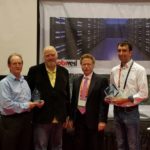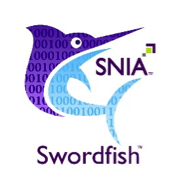 by George Ericson, Distinguished Engineer, Dell EMC; Member,
by George Ericson, Distinguished Engineer, Dell EMC; Member,
SNIA Scalable Storage Management Technical Working Group,
@GEricson
Introduction
This blog is part two of a three-part series by George Ericson, a distinguished engineer at Dell EMC. If you missed part one, you can read it here. George is an active participant on the SNIA Scalable Storage Management Technical Working Group which has been developing the SNIA Swordfish storage management specification.
storage management specification.
SNIA Swordfish is designed to integrate with the technologies used in cloud data center environments and can be used to accomplish a broad range of storage management tasks from the simple to the advanced. SNIA is holding the very first Swordfish plugfest June 13-15 in the SNIA Technology Center in Colorado Springs.
Overview
We are making strides toward universal and interoperable management interfaces. These are not only interfaces that will interoperate across one vendor or one part of the stack, but management interfaces that can truly integrate your infrastructure management. Last time, we discussed OData, the Rest standardization. This time we will talk about Redfish for managing hardware platforms.
DMTF’s Redfish®
Redfish defines a simple and secure, OData conformant data service for managing scalable hardware platforms. Redfish is defined by a set of open industry standard specifications that are developed by the Distributed Management Task Force, Inc. (DMTF).
The initial development was from the point of view of a Baseboard Management Controller (BMC) or equivalent. Redfish management currently covers bare-metal discovery, configuration, monitoring, and management of all common hardware components. It is capable of managing and updating installed software, including for the operating system and for device drivers.
Redfish is not limited to low-level hardware/firmware management. It is also expected to be deployed to manage higher level functionality, including configuration and management of containers and virtual systems. In collaboration with the IETF, Redfish is also being extended to include management of networks.
The Redfish Scalable Platforms Management API Specification specifies functionality that can be divided into three areas: OData extensions, utility interfaces, and platform management interfaces. These are described briefly in the following sections.
Redfish OData extensions
Redfish requires at least OData v4 and specifies some additional constraints:
- Use of HTTP v1.1 is required, with support for POST, GET, PATCH, and DELETE operations, including requirements on many HTTP headers
- JSON representations are required within payloads
- Several well-known URIs are specified
- /redfish/v1/ returns the ServiceRoot resource for locating resources
- /redfish/v1/OData/ returns the OData service document for locating resources
- /redfish/v1/$metadata returns the OData metadata document for locating the entity data model declarations.
Redfish also extends the OData metamodel with an additional vocabulary for annotating model declarations. The annotations specify information about, or behaviors of the modeled resources.
Redfish utility interfaces
The utility interfaces provide functionality that is useful for any management domain (for example, these interfaces are used by Swordfish for storage management). These interfaces include account, event, log, session, and task management.
The account service manages access to a Redfish service via a manager accounts and roles.
The event service provides the means to specify events and to subscribe to indications when a defined event occurs on a specified set of resources. Each subscription specifies where indications are sent, this can be to a listening service or to an internal resource, (e.g. a log service).
Each log service manages a collection of event records, including size and replacement policies. Resources may have multiple log services for different purposes.
The session service manages sessions and enables creation of an X-Auth-Token representing a session used to access the Redfish service.
The task service manages tasks that represent independent threads of execution known to the redfish service. Typically tasks are spawned as a result of a long running operation.
The update service provides management of firmware and software resources, including the ability to update those resources.
Redfish platform management interfaces
The principal resources managed by a Redfish service are chassis, computer systems and fabrics. Each resource has its current status. Additionally, each type of resource may have references to other resources, properties defining the current state of the resource, and additional actions as necessary.
Each chassis represents a physical or logical container. It may represent a sheet-metal confined space like a rack, sled, shelf, or module. Or, it may represent a logical space like a row, pod, or computer room zone.
Each computer system represents a computing system and its software-visible resources such as memory, processors and other devices that can be accessed from that system. The computer system can be general purpose system or can be a specialized system like a storage server or a switch.
Each fabric represents a collection of zones, switches and related endpoints. A zone is a collection of involved switches and contained endpoints. A switch provides connectivity between a set of endpoints.
All other subsystems are represented as resources that are linked via one or more of these principal resources. These subsystems include: bios, drives, endpoints, fans, memories, PCIe devices, ports, power, sensors, processors and various types of networking interfaces.
Conclusion
Redfish delivers a standardized management interface for hardware resources. While it is beginning with basic functionality like discovery, configuration and monitoring, it will deliver much more. It will extend into both richer services and cover more than physical resources – e.g. virtual systems, containers, and networks. Redfish is built as an OData conformant service, which makes it the second connected part of an integrated management API stack. Next up – Swordfish.
 NVMe over Fabrics high-performance storage software were recognized for creating an open storage management specification that works with EXTEN storage software for being the first in the industry to provide a solution based on SNIA Swordfish
NVMe over Fabrics high-performance storage software were recognized for creating an open storage management specification that works with EXTEN storage software for being the first in the industry to provide a solution based on SNIA Swordfish and DMTF Redfish® specifications. “We congratulate EXTEN Technologies for its innovation and well-deserved accolade,” said Don Deel, SNIA Storage Management Initiative Governing Board Chair. “By integrating SNIA Swordfish into its solution, EXTEN Technologies’ customers will benefit from a standards-based API that does not require learning the intricacies of storage infrastructure to handle day-to-day storage needs.” Accepting the award for SNIA at FMS were Mark Carlson of SNIA member company Toshiba Memory Systems and Bill Miller of SNIA member company Samsung Electronics, Co-Chairs of the SNIA Technical Council.
Congratulations to all the SNIA volunteers who participated in the development of these award-winning specifications.
SNIA Sessions at FMS Now Available for Viewing and Download Read More
and DMTF Redfish® specifications. “We congratulate EXTEN Technologies for its innovation and well-deserved accolade,” said Don Deel, SNIA Storage Management Initiative Governing Board Chair. “By integrating SNIA Swordfish into its solution, EXTEN Technologies’ customers will benefit from a standards-based API that does not require learning the intricacies of storage infrastructure to handle day-to-day storage needs.” Accepting the award for SNIA at FMS were Mark Carlson of SNIA member company Toshiba Memory Systems and Bill Miller of SNIA member company Samsung Electronics, Co-Chairs of the SNIA Technical Council.
Congratulations to all the SNIA volunteers who participated in the development of these award-winning specifications.
SNIA Sessions at FMS Now Available for Viewing and Download Read More


 The Storage Networking Industry Association’s (SNIA’s) Storage Management Initiative (SMI) took on the topic of SNIA Swordfish
The Storage Networking Industry Association’s (SNIA’s) Storage Management Initiative (SMI) took on the topic of SNIA Swordfish in a live webcast titled “
in a live webcast titled “ The Storage Networking Industry Association’s (SNIA’s) Storage Management Initiative (SMI) took on the topic of SNIA Swordfish
The Storage Networking Industry Association’s (SNIA’s) Storage Management Initiative (SMI) took on the topic of SNIA Swordfish in a live webcast titled “
in a live webcast titled “ The Storage Networking Industry Association’s (SNIA’s) Storage Management Initiative (SMI) took on the topic of SNIA Swordfish™ in a live webcast titled “
The Storage Networking Industry Association’s (SNIA’s) Storage Management Initiative (SMI) took on the topic of SNIA Swordfish™ in a live webcast titled “ by George Ericson, Distinguished Engineer, Dell EMC; Member,
by George Ericson, Distinguished Engineer, Dell EMC; Member, by George Ericson, Distinguished Engineer, Dell EMC; Member,
by George Ericson, Distinguished Engineer, Dell EMC; Member,
 by George Ericson, Distinguished Engineer, Dell EMC; Member,
by George Ericson, Distinguished Engineer, Dell EMC; Member,